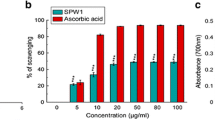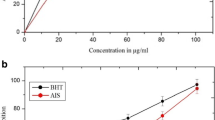Abstract
Phyllanthus fraternus is widely used in the cure of various liver diseases and possess antiviral properties especially against hepatitis virus. In the present study, evaluation of the antioxidant activity of stem and calli induced from stem has been done by different assays. Extraction was done by standard method in water and ethanol. Total antioxidant capacity was measured by 1, 1-diphenyl-2-picrylhydrazyl free radical scavenging method. Lipid peroxidation was measured in terms of thiobarbituric acid-reactive substances (TBARS) by using egg yolk homogenates as lipid-rich media, and superoxide radical scavenging activity was measured using riboflavin–light–nitro blue tetrazolium assay. Reducing power was determined on the basis of Fe3+–Fe2+ transformation in the presence of the extract. In addition to the antioxidant activity, polyphenolic compounds like total phenolics and flavonoids were also measured by spectroscopic method. Results showed that the ethanolic extract of stem is more potent in antioxidant activity than its aqueous extract and ethanolic extract of calli. A significant correlation between antioxidant capacity and polyphenolic content and reducing potential was observed, indicating that phenolic compounds and reducers present in extract are major contributors to the antioxidant potential. Thus, this plant extract could be used as a potent natural antioxidant.




Similar content being viewed by others
Abbreviations
- ROS:
-
Reactive oxygen species
- DPPH:
-
1, 1-Diphenyl-2-picrylhydrazyl
- TP:
-
Total phenolics
- TF:
-
Total flavonoids
References
Gutteridge, J. M. C. (1995). Clinical Chemistry, 41, 1819–1828.
Halliwell, B. (1995). American Journal of Medicine, 91, 14–22.
Aruoma, O. I. (1998). Journal of American Oil Chemists Society, 75, 199–212.
Valko, M., Rhodes, C. J., Moncol, J., Izakovic, M., & Mazur, M. (2006). Chemico Biological Interactions, 160, 1–40.
Eastwood, M. A. (1999). Quarterly Journal of Medicine, 92, 527–530.
Ndhlala, A. R., Kasiyamhuru, A., Mupure, C., Chitindingu, K., Benhura, M. A., & Muchuweti, M. (2007). Food Chemistry, 103, 82–87.
Djeridane, A., Yousfi, M., Nadjemi, B., Boutassouna, D., Stocker, P., & Vidal, N. (2006). Food Chemistry, 97, 654–660.
Jayaprakash, G. K., & Rao, L. J. (2000). Z Naturforsch, 55, 1018–1022.
Abedin, S., Mossa, J.S., AI-Said, M.S., AI-Yahya, M.A. (2001). In S.A. Chaudhary (ed.) Flora of Kingdom of Saudi Arabia, p. 298. Riyadh: National Agriculture and Water Research Centre
Hukkeri, V. I., Kalyani, G. A., & Kakrani, H. K. (1998). Fitoterapia, 59, 68–70.
Kalyani, B., Shekshavali, T., Vishwanatha Swamy, K. M., & Ram Chandra Setty, S. (2010). Pharmacologyonline, 3, 164–173.
Chopade, A. R., & Sayyad, F. J. (2012). Asian Pacific Journal of Tropical Biomedicine, 1–4.
Koffuor, G. A., & Amoateng, P. (2011). Journal of Pharmacology and Toxicology, 6, 624–636.
Lin, J., Opoku, A. R., Geheeb-Keller, M., Hutchings, A. D., Terblanche, S. E., Jageran, A. K., & Staden, J. V. (1999). Journal of Ethnopharmacology, 68, 267–274.
Braca, A., Tommasi, N. D., Bari, L. D., Pizza, C., Politi, M., & Morelli, I. (2001). Journal of Natural Products, 64, 892–895.
Ohkowa, H., Ohisi, N., & Yagi, K. (1979). Analytical Biochemistry, 95, 3513–3558.
Ruberto, G., Baratta, M. T., Deans, S. G., & Dorman, H. J. D. (2000). Planta Medica, 66, 687–693.
Janero, D. R. (1990). Free Radical Biology & Medicine, 9, 515–540.
Beauchamp, C., & Fridovich, I. (1971). Analytical Biochemistry, 44, 276–287.
Oyaizu, M. (1986). Japanese Journal of Nutrition, 44, 307–315.
Lister, E., & Wilson, P. (2001). Measurement of total phenolics and ABTS assay for antioxidant activity. Lincoln, New Zealand: Crop Research Institute.
Chang, C. C., Yang, M. H., Wen, H. M., & Chern, J. C. (2002). Journal of Food and Drug Analysis, 10, 178–182.
Korycka-Dahl, M., & Richardson, T. (1978). Journal of Dairy Science, 61, 400–407.
Halliwell, B., & Aruoma, O. I. (1991). FEBS Letter, 281, 9–19.
Meir, S., Joseph Kanner, J., Bezalel Akiri, B., & Sonia Philosoph-Hadas, S. (1995). Journal of Agriculture and Food Chemistry, 43, 1813–1819.
Diplock, A. T. (1997). Free Radical Research, 27, 511–532.
Havesteen, B. (1983). Biochemistry and Pharmacology, 32, 1141–1148.
Hatano, T., Edamatsu, R., Mori, A., Fujita, Y., & Yasuhara, E. (1989). Chemical and Pharmaceutical Bulletin, 37, 2016–2021.
Sharma, V., & Ramawat, K. G. (2013). 3 Biotech, 3, 11–17.
Chirinos, R., Pedreschi, R., Rogez, H., Larondelle, Y., & Campos, D. (2013). Industrial Crops and Products, 471, 45–152.
Koleva, I. I., Van, B. T. A., & Linssen, J. P. H. (2002). Phytochemical Analysis, 13, 8–17.
Ahuja, M. R., Evens, D. A., Sharp, W. R., & Ammirato, P. J. (1986). Handbook of plant cell culture (pp. 626–651). New York: Macmillan.
Tahir, S. M., Victor, K., & Abdulkadir, S. (2011). Nigerian Journal of Basic and Applied Science, 19, 213–217.
Verpoote, R., Heijden, R. V. D., Hoge, H., & Hoopen, H. (1994). Pure Applied Chemistry, 66, 2307–2310.
Tadhani, M. B., Patel, V. H., & Subhash, R. (2007). Journal of Food Composition and Analysis, 20, 323–329.
Giri, L., Dhyania, P., Rawata, S., Bhatta, I. D., Nandia, S. K., Rawala, R. S., & Pande, V. (2012). Industrial Crops and Products, 39, 1–6.
Hegazi, G. A. E. (2011). World Applied Science Journal, 14, 679–686.
Sharma, N., & Patni, V. (2013). International Journal of Pharma and Pharmaceutical Sciences, 5, 464–469.
Parsaeimehr, A., Sargsyan, E., & Javidni, K. (2010). Molecules, 15, 1668–1678.
Acknowledgments
R. Upadhyay is highly thankful to the Council of Scientific and Industrial Research (CSIR), New Delhi, for providing fellowship as senior research fellow.
Author information
Authors and Affiliations
Corresponding author
Rights and permissions
About this article
Cite this article
Upadhyay, R., Chaurasia, J.K., Tiwari, K.N. et al. Comparative Antioxidant Study of Stem and Stem Induced Callus of Phyllanthus fraternus Webster—An Important Antiviral and Hepatoprotective Plant. Appl Biochem Biotechnol 171, 2153–2164 (2013). https://doi.org/10.1007/s12010-013-0487-5
Received:
Accepted:
Published:
Issue Date:
DOI: https://doi.org/10.1007/s12010-013-0487-5




